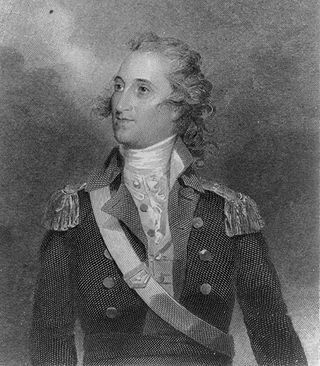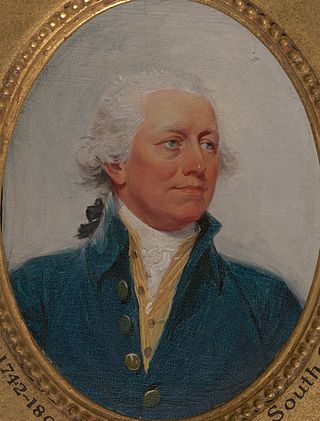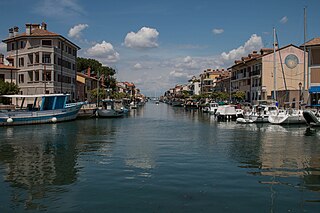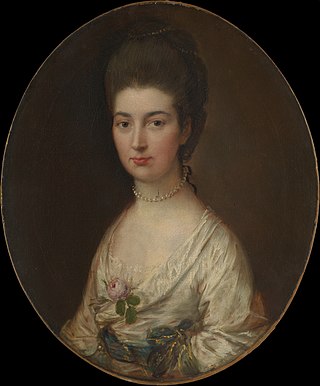
Henry Middleton was a planter, public official from South Carolina. A member of the colonial legislature, during the American Revolution he attended the First Continental Congress and served as that body's president for four days in 1774 after the passage of the Continental Association, which he signed. He left the Second Continental Congress before it declared independence. Back in South Carolina, he served as president of the provincial congress and senator in the newly created state government. After his capture by the British in 1780, he accepted defeat and returned to the status of a British subject until the end of the war.

Arthur Middleton was a Founding Father of the United States, signer of the United States Declaration of Independence, and a representative from South Carolina in the Second Continental Congress.

Thomas Pinckney was an American statesman, diplomat, and military officer who fought in both the American Revolutionary War and the War of 1812, achieving the rank of major general. He served as Governor of South Carolina and as the U.S. minister to Great Britain.

Ralph Izard was a U.S. politician. He served as President pro tempore of the United States Senate in 1794.

The Villa Giulia is a villa in Rome, Italy. It was built by Pope Julius III in 1551–1553 on what was then the edge of the city. Today it is publicly owned, and houses the Museo Nazionale Etrusco, a collection of Etruscan art and artifacts.

The province of Trieste is a province in the autonomous Friuli-Venezia Giulia region of Italy. Its capital was the city of Trieste. It had an area of 212 square kilometres (82 sq mi) and it had a total population of 234,668. It had a coastal length of 48.1 kilometres (29.9 mi). Abolished in 2017, it was reestablished in 2019 as the regional decentralization entity of Trieste, and was reactivated on 1 July 2020.
John Middleton may refer to:

USS Izard (DD-589), a Fletcher-class destroyer, was a ship of the United States Navy named for Lieutenant Ralph Izard (1785–1822),

Grado is a town and comune (municipality) of 8,064 residents in the Regional decentralization entity of Gorizia in the north-eastern Italian region of Friuli-Venezia Giulia, located on an island and adjacent peninsula of the Adriatic Sea between Venice and Trieste. The territory of the municipality of Grado extends between the mouth of the Isonzo and the Adriatic Sea and the Grado Lagoon, and covers an area of about 90 square kilometers between Porto Buso and Fossalon. Characteristic of the lagoon is the presence of the casoni, which are simple houses with thatched roof used in the past by the fishermen of Grado, who remained in the lagoon for a long time, returning to the island of Grado only during the colder period of the year.
John Izard Middleton was an American archeologist and artist who was dubbed "the first American Classical Archaeologist" by Charles Eliot Norton.
The Fountain of Valle Giulia is a fountain in the Valle Giulia area of Rome. It was immortalised in the symphonic poem Fontane di Roma by Ottorino Respighi.

Montelapiano is a comune and town in the Province of Chieti in the Abruzzo region of Italy. It is the smallest non alpine commune in Italy by population.
The Battle of Valle Giulia is the conventional name for a clash between Italian militants and the Italian police in Valle Giulia, Rome, on 1 March 1968. It is still frequently remembered as one of the first violent clashes in Italy's student unrest during the protests of 1968 or "Sessantotto".
Williams Middleton best known as a signer of the South Carolina Ordinance of Secession, and as one of the owners of Middleton Place, National Historic Landmark gardens outside Charleston, SC.

Peter Manigault was an attorney, plantation owner, slave owner, and colonial legislator native to Charleston, South Carolina. He was the wealthiest man in the British North American colonies at the time of his death and owned hundreds of slaves. He was the son-in-law of Joseph Wragg, the largest slave trader of North America in the 1730s.

Giulia Valle was an Italian Roman Catholic nun and a professed member of the Sisters of Charity of Saint Joan Antida Thouret; she later assumed the religious name of "Nemesia" upon becoming a professed nun. Following her profession, she became an educator in Turin and the surrounding areas and was known for her careful attention to people's individual educational needs.

James-Alexandre de Pourtalès, Comte de Pourtalès-Gorgier was a Swiss-French banker, diplomat and art collector.

Alice De Lancey Izard was an American socialite. Her life was one of varied experiences, reaching from the seclusion of a South Carolina plantation where she introduced the culture of silkworms, hoping it to be a benefit to the state, to the social life in European cities. She spent several winters prior to the American Revolution in London society, after which she resided in Paris, where she was said to be admired at exclusive French salons. She accompanied her husband, Ralph Izard, to the Court of the Grand Duke of Tuscany. Mrs. Izard took on the role of a politician's wife while her husband served as a U.S. Senator. In her later years, widowed, she conducted dinner parties in Philadelphia, Pennsylvania.












